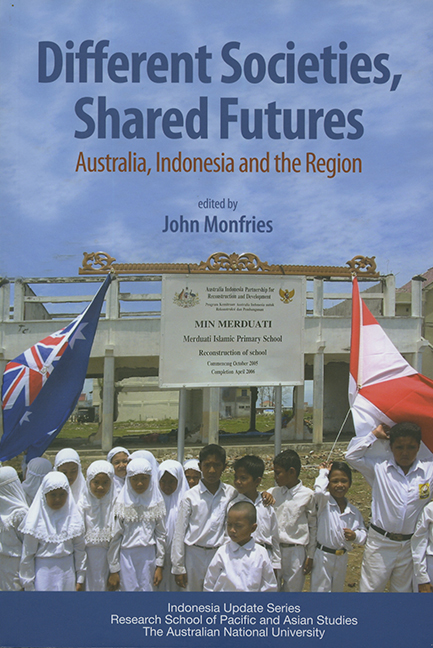Book contents
- Frontmatter
- Dedication
- Contents
- Tables
- Figures
- Contributors
- Acknowledgments
- Opening Address by Richard Woolcott AC
- 1 Introduction
- PART I Regional Viewpoints
- 2 An Indonesian View: Indonesia, Australia and the Region
- 3 A Regional View: The Garuda and the Kangaroo
- 4 An Australian View: The Outlook for the Relationship
- PART II Security Aspects
- PART III Mutual Perceptions and Irritations
- PART IV The Economic Partnership: Aid, Economics and Business
- PART V Conclusion
- Glossary
- References
- Index
2 - An Indonesian View: Indonesia, Australia and the Region
from PART I - Regional Viewpoints
Published online by Cambridge University Press: 21 October 2015
- Frontmatter
- Dedication
- Contents
- Tables
- Figures
- Contributors
- Acknowledgments
- Opening Address by Richard Woolcott AC
- 1 Introduction
- PART I Regional Viewpoints
- 2 An Indonesian View: Indonesia, Australia and the Region
- 3 A Regional View: The Garuda and the Kangaroo
- 4 An Australian View: The Outlook for the Relationship
- PART II Security Aspects
- PART III Mutual Perceptions and Irritations
- PART IV The Economic Partnership: Aid, Economics and Business
- PART V Conclusion
- Glossary
- References
- Index
Summary
Despite many difficulties and tensions, the improved relationship between Indonesia and Australia offers opportunities in both the regional and bilateral context. A window of opportunity has opened for Australia to come closer to the Association of Southeast Asian Nations (ASEAN) as a dialogue partner, with Indonesian encouragement. For its part, Australia responded promptly and vigorously to the tsunami disaster in a way that was much appreciated in Indonesia. The visit of the Indonesian president to Australia further enhanced the relationship. Nevertheless, Australian public ignorance of Indonesia, and Indonesian public ignorance of Australia, remain all too evident. The disjuncture between official relations and public perceptions requires a major effort at public diplomacy, complemented by the efforts of private institutions, groups and individuals, if such misperceptions and misunderstandings are to be overcome.
INDONESIAN FOREIGN POLICY AND REGIONAL ARCHITECTURE
Although Indonesia comprises about 50 per cent of ASEAN by population, it will not be able to continue to play its traditional stabilising and leadership role in the region unless it is successful in addressing the internal imperatives of reform, social stability and economic growth. This may still take a few years to be realised. ASEAN, on the other hand, sees itself as part of a regional architecture in which one wing is composed of India and China and the other by South Korea and Japan. Australia, New Zealand and the United States serve as sources of additional support. Today, East Asia is dominated by China with its gigantic and overheated economy. The only challenge to China's economic dominance comes from India, but it has a long way to go before it will be able to match China in economic strength.
Indonesia sees the entire Asia-Pacific region as in need of a process that will ensure political and economic equilibrium in the area. This is not only because of China's dominance as an economic power but also because of its recent successes on the diplomatic front, which contrast with the massive erosion of the soft power of the United States in the region.
- Type
- Chapter
- Information
- Different Societies, Shared FuturesAustralia, Indonesia and the Region, pp. 11 - 19Publisher: ISEAS–Yusof Ishak InstitutePrint publication year: 2006



